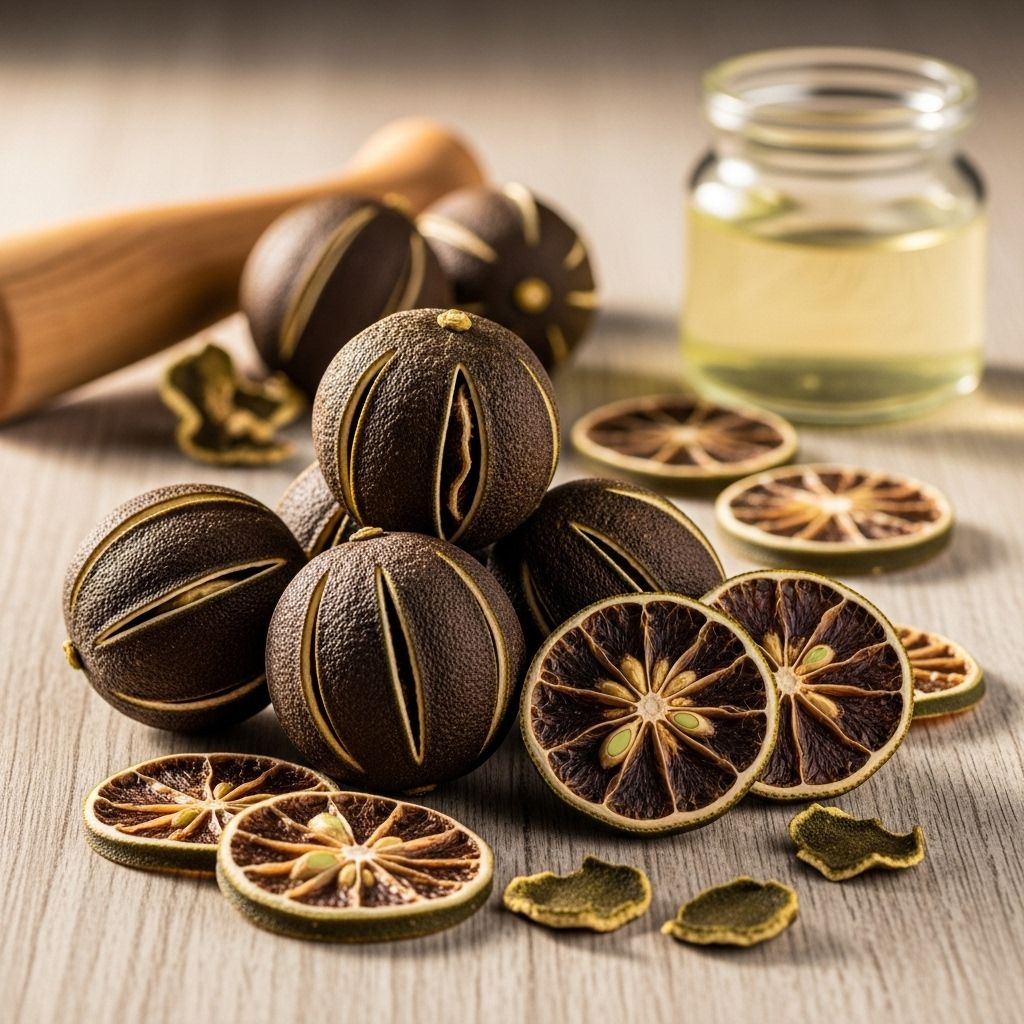Unlocking the Secrets of Dried Lime: Benefits, Uses, and Taste
Discover the culinary magic of dried lime and how it enhances your dishes

Introduction to Dried Lime
Dried lime, also known as black lime or *limu aman* in Middle Eastern cuisine, is a sun-dried lime fruit commonly used in Middle Eastern and Asian cuisines. This condiment is known for its unique, complex flavor profile, which includes tartness, earthiness, bitterness, and umami notes. Unlike fresh limes, dried lime offers a smoky, briny taste and is often used to enhance stews, marinades, and various dishes.
What is Dried Lime?
Dried lime is produced by sun-drying limes until their moisture content drops significantly. This process results in a wrinkled, brownish orb that retains its intense citrus flavor but with a more robust, earthy aroma. The dried fruit is almost round to oval in shape and ranges in color from light brown to dark brown, depending on the drying method.
| Flavor Note | Description |
|---|---|
| Tartness | Similar to biting into the zestiest lemon peel |
| Earthy | Reminiscent of aged tea leaves or dried mushrooms |
| Bitter | Subtle but present, similar to orange peel |
| Umami | Slight savory depth perfect for soups and broths |
Benefits of Dried Lime
Dried lime offers several benefits, including its ability to add depth and complexity to dishes without needing refrigeration. Its shelf life is long, making it a convenient pantry staple. It is also versatile, as it can be used in various forms—whole, grated, or powdered.
Uses of Dried Lime
Dried lime is incredibly versatile and can be used in multiple culinary contexts:
- Stews and Soups: Adding whole dried limes to stews, like the traditional Iraqi dish “loomi,” enhances the broth with a unique flavor. It is essential to pierce the limes multiple times to increase the surface area for flavor release.
- Marinades and Salads: Grate dried lime over salads or mix it with olive oil and garlic for a gourmet salad dressing. It also breaks down proteins more effectively than fresh citrus when used in marinades.
- Chocolate Desserts: Surprisingly, a pinch of dried lime powder can enhance the cocoa notes in chocolate desserts, adding a citrus accent without a citrusy taste.
- Tomato-Based Sauces: A small amount of dried lime can cut through acidity better than sugar and add depth to pasta sauces.
Use in Middle Eastern Cuisine
In Middle Eastern cuisine, particularly in Persian cooking, dried lime is considered one of the three pillars of flavor alongside saffron and rosewater. It is used not just as a garnish but as a fundamental flavor builder in dishes.
Storage and Preparation Tips
To maintain the potency of dried lime, it should be stored in a dry, well-sealed container. For optimal flavor extraction, rehydrate dried lime in warm broth or water for 15 minutes before use. Alternatively, “bloom” dried lime powder in a small amount of warm oil before adding it to dishes to unlock its full aromatic potential.
Frequently Asked Questions (FAQs)
Q: What is the difference between dried lime and dried lime zest?
A: Dried lime is the sun-dried fruit, while dried lime zest is made from the outer peel of the lime, containing the highest oil content and most pleasing flavor.
Q: How do I choose the best dried lime?
A: Look for dried limes that are homogeneous in color and size, have a natural characteristic odor and taste, and are free from contaminants and abnormal odors.
Q: In which cuisines is dried lime commonly used?
A: Dried lime is most commonly used in Middle Eastern and Asian cuisines, particularly in Persian and Iraqi cooking.
Taste and Flavor Profile of Dried Lime
The flavor of dried lime is complex and includes notes of tartness, earthiness, bitterness, and umami. This unique combination makes it a versatile ingredient for enhancing both savory and sweet dishes. Its smoky, citrusy aroma is a result of the drying process, which concentrates the flavors.
Culinary Pairings for Dried Lime
Dried lime pairs well with a variety of ingredients and spices, including saffron, rosewater, garlic, and olive oil. It can be used in marinades, soups, stews, and even as a seasoning for grains like rice.
Preservation and Quality Control
For dried lime to maintain its quality, it must be packed in clean, dry, and well-sealed containers to prevent contamination. Regular testing for microbial and chemical contaminants is essential to ensure safety and quality.
References
- https://spice.alibaba.com/spice-basics/7-zesty-secrets-of-dried-lime-you-never-knew-but-totally-need
- https://spicesinc.com/lime-peel
- https://arabicgum.sd/wp-content/uploads/2020/11/Dried-Lime.pdf
- https://en.wikipedia.org/wiki/Lime_(material)
- https://nutriboom.eu/blogs/news/the-delicious-delight-of-limes-exploring-the-flavourful-world-of-freeze-dried-limes
- https://talesofthecocktail.org/heard-black-lime-heres-how-use-it/
- https://pmc.ncbi.nlm.nih.gov/articles/PMC8343908/
- https://www.healthline.com/nutrition/limes
Read full bio of medha deb












